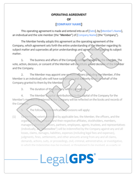What to Do When a Contractor Ghosts You Mid-Project
You’ve hired a web developer to build your startup’s website, and things are going smoothly—until they stop responding. Emails go unanswered,...
6 min read
LegalGPS : Sep. 15, 2025
You’re halfway through renovating your café, excited about the new look, when your contractor drops a bombshell: they need an extra $5,000 to finish the job. They cite rising material costs, but you’re blindsided—your budget is already stretched, and delays could tank your grand reopening. When a contractor asks for more money mid-project, it’s a gut punch that threatens your finances, timeline, and trust. Do you pay up, negotiate, or stand your ground?


Legal GPS Pro
Protect your business with our complete legal subscription service, designed by top startup attorneys.
This guide walks you through how to handle a contractor’s mid-project cost increase, offering a clear, actionable plan to evaluate their request, protect your budget, and keep your project on track. From reviewing contracts to strengthening future agreements, we’ll cover five key steps, packed with real-world examples and practical “Pro Tips” to navigate this challenge. Whether you’re a freelancer, startup founder, or small business owner, let’s tackle this hurdle and finish your project strong.

Consulting Agreement
Download our Consulting Agreement Template to formalize your consulting services. Protect your business with a clear comprehensive contract.
Trusted by 1,000+ businesses to safeguard their LLCs.
Your first move is to check what you and the contractor agreed to in writing. The contract is your anchor, so dig it out and scrutinize its pricing and scope details.
Look for clauses that define costs: Is it a fixed-price contract (e.g., “$10,000 for complete renovation”)? Does it include estimates that allow for adjustments? Check for allowances, like “$2,000 for flooring, subject to market rates,” or provisions for unforeseen costs, such as “additional charges for structural repairs with prior approval.” Pay attention to the scope of work—what tasks were included, and does the contractor’s request align with it? Also, look for change order clauses, which outline how cost increases should be handled, often requiring written agreement.
Document the contractor’s request: note the amount, reason given, and date. Compare it to the contract to see if it’s justified or a breach of terms. If the contract is vague or verbal, emails or invoices might clarify the original agreement, but they’re less binding.
Jane, a boutique owner, hired a contractor for a $15,000 store renovation. Mid-project, they requested an extra $3,000 for “unexpected plumbing issues.” Jane reviewed the contract, which specified a fixed price of $15,000 with no allowance for additional costs unless pre-approved. The scope didn’t include plumbing repairs, so Jane had grounds to challenge the request. Her contract review saved her from an unwarranted expense.
Mark up a digital or printed copy of the contract with a highlighter or comments to flag pricing, scope, and change order clauses. Store it in Google Drive for easy access. This quick reference helps you respond confidently to cost requests and spot when a contractor’s demand doesn’t align with the agreement.
Before agreeing or refusing, dig into why the contractor needs more money. A legitimate reason, like a material price spike, might warrant discussion, while poor planning or errors on their part don’t.
Ask for a detailed explanation in writing. Is it due to rising costs (e.g., lumber prices up 20%)? Unforeseen issues (e.g., hidden electrical faults)? Or a scope change you requested (e.g., adding a feature)? Request documentation to verify their claim—supplier invoices, price quotes, or photos of unexpected issues. Assess whether the issue was foreseeable. For example, a contractor should anticipate basic material costs, but sudden market surges might be out of their control.
If the request stems from their mistake, like underestimating labor, that’s their responsibility, not yours. If it’s a genuine issue, like a regulatory change, you’ll need to weigh your options. This step ensures you’re not being taken advantage of.
Mike, a startup founder, hired a developer for a $4,000 website project. Mid-way, the developer asked for $1,000 more, citing new API fees from a third-party service. Mike requested a breakdown and saw invoices showing the API costs had doubled unexpectedly. Since the contract allowed adjustments for “third-party fee changes,” Mike agreed to pay $600, splitting the cost. His due diligence confirmed the request’s legitimacy.
Ask the contractor for an itemized list of additional costs, including labor, materials, and any fees. Specify you want it in writing (email or letter) within 3–5 days. This forces transparency and gives you concrete data to negotiate or dispute. Save the breakdown alongside your contract for reference.
Armed with the contract and the contractor’s reasoning, negotiate a solution that balances your budget and their needs. The goal is to keep the project moving without overpaying.
Start by referencing the contract. If it’s fixed-price or lacks a change order clause, remind the contractor of the agreed terms and push back on unjustified increases. Propose alternatives: split the cost (e.g., 50/50 for legitimate issues), reduce the scope (e.g., skip non-essential features), or extend the timeline to lower labor costs. If the request is valid, like a material price surge, consider paying a portion to maintain goodwill.
Document all negotiations—emails, call notes, or in-person agreements. Finalize any cost increase with a signed change order, a written amendment to the contract specifying the new price and scope. This prevents misunderstandings and protects you legally.
Laura, an entrepreneur, hired a contractor for a $20,000 office build. They requested $4,000 extra for steel price hikes. The contract allowed “reasonable material cost adjustments” with proof. Laura verified the increase with supplier quotes and negotiated a 50/50 split, paying $2,000. They signed a change order, and the project finished on time. Laura’s negotiation saved $2,000 while keeping the contractor motivated.
Formalize cost agreements with a change order form, signed by both parties. Include the new cost, revised scope, and completion date. Find free templates on SBA.gov or create a simple document in Word. This ensures clarity and prevents the contractor from claiming further increases without approval.
A cost increase can strain your finances and delay your project, so take steps to manage the impact and keep things on track.
Reassess your budget. If you agree to extra costs, cut non-essential expenses elsewhere—maybe delay marketing or trim decor spending. If the increase isn’t justified and you refuse, prepare for potential delays or the contractor walking away, and line up a backup. Use budgeting tools like QuickBooks to track expenses and stay within your limits.


Legal GPS Pro
Protect your business with our complete legal subscription service, designed by top startup attorneys.
Monitor the contractor’s progress closely. Request weekly updates or site visits to ensure they’re meeting milestones, especially after a cost dispute. If the project affects clients or stakeholders, communicate transparently—email them with a revised timeline and offer a gesture, like a discount, to maintain trust. For example, a delayed store opening might warrant a 10% off coupon for customers.
Tom, a café owner, faced a $2,500 cost increase for roofing repairs during an expansion. His contract capped increases at 10% ($2,000), so he paid that and negotiated the rest as a contractor expense. Tom cut $500 from new furniture purchases to stay on budget and emailed customers about a one-week delay, offering free coffee at the reopening. His proactive moves kept the project and customer goodwill intact.
Use tools like QuickBooks or Wave to monitor contractor payments and project expenses in real time. Set budget alerts to flag when you’re nearing your limit. These tools, starting at $15/month, help you catch overspending early and maintain financial control.
A mid-project cost request is a lesson to tighten your contracts. Better agreements and vetting can minimize surprises and protect your budget.
Revise contracts to include fixed-price clauses (e.g., “$10,000 total, no adjustments without written consent”) or caps on cost overruns (e.g., “maximum 10% increase”). Specify a change order process requiring your approval for any extra costs, with detailed justification. Add clear scope definitions to prevent contractors from claiming “extra work.” Have a lawyer review the contract to ensure it’s enforceable in your state.
Vet contractors thoroughly. Ask for three references and call them to ask about budget adherence and reliability. Review their past projects for cost overruns via online reviews or industry contacts. Discuss their approach to cost management upfront—reputable contractors will be transparent about risks.
Emma, a freelancer, hired a marketer for a $3,000 campaign, but they requested $1,000 more for “additional ad placements.” The contract lacked a cost cap, so Emma paid $500 to finish. For future projects, she added a 5% overrun cap and a change order clause requiring written quotes. Her next campaign stayed on budget, thanks to her updated contract.
Add a clause allowing a small budget buffer (e.g., 10% or $1,000) for unforeseen costs, subject to your approval. This gives flexibility for legitimate issues while capping your exposure. Discuss this clause with contractors during hiring to set expectations and avoid mid-project shocks.
When your contractor asks for more money mid-project, it’s a test of your preparation and negotiation skills. By reviewing the contract, understanding the request, negotiating fairly, protecting your budget, and strengthening future agreements, you can manage the situation and keep your project on course. Start today by pulling your contract and checking its cost terms—knowing your rights is your first defense.
Have you faced a contractor’s cost increase or worry about one? Share your story in the comments or reach out with questions. Your project deserves to succeed—let’s make it happen.
The biggest question now is, "Do you need a lawyer for your business?” For most businesses and in most cases, you don't need a lawyer to start your business. Instead, many business owners rely on Legal GPS Pro to help with legal issues.
Legal GPS Pro is your All-In-One Legal Toolkit for Businesses. Developed by top startup attorneys, Pro gives you access to 100+ expertly crafted templates including operating agreements, NDAs, and service agreements, and an interactive platform. All designed to protect your company and set it up for lasting success.

Legal GPS Pro
Protect your business with our complete legal subscription service, designed by top startup attorneys.
|
Premium Template
Single-use Template |
Legal GPS Pro
Unlimited Access, Best Value |
|
|
| Choose Template | Learn More |
| Trusted by 1000+ businesses | |

You’ve hired a web developer to build your startup’s website, and things are going smoothly—until they stop responding. Emails go unanswered,...

You’ve hired a contractor, agreed on a timeline, and planned your project around their promised completion date. But as the deadline approaches, the...

You’re a freelancer, thrilled to land a big client, but their contract arrives, and it’s a red-flag parade: they can cancel anytime, you’re liable...